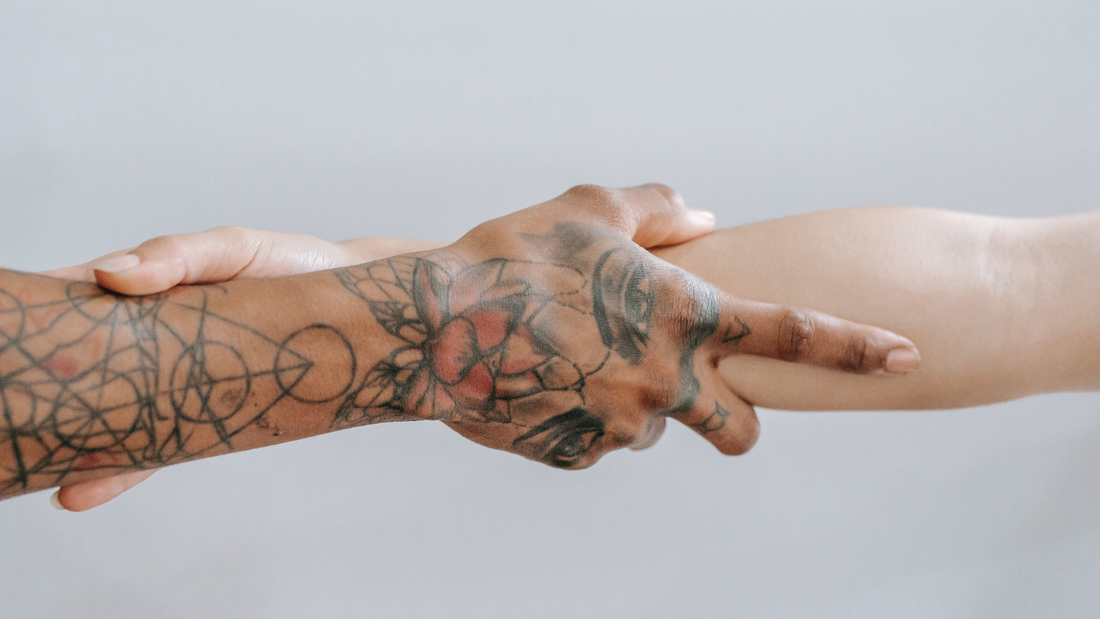
Tattoo Aging
Share
Aging is a natural process, and with the older we get, the more our skin changes. But what does this mean for your tattoos? How exactly do tattoos age?
If, like us, you want to ensure your tattoos have the longest life possible, there are a few small things you can do to extend their lifespan.
So, how do tattoos fade over time?
The main signs of tattoo aging include the ink’s pigment breaking down, causing your tattoo to appear blurry, stretched, wrinkled or less vibrant than it once was. Good news is, you have the power to slow down your tattoos’ aging process!
Here’s everything you should know about the reasons for tattoo aging and how to prevent it.

What are the reasons for tattoo aging?
High sun exposure
Tattoos do fade over time and one of the main reasons for this accelerated process is sun exposure. So, how exactly do tattoos age due to sun exposure? Well, unsurprisingly, it comes down to the effect of UV rays.
There are two types of ultraviolet radiation emitted by the sun, named UVA and UVB, and both have an impact on tattoo aging. UVB rays, by reaching the first layer of your skin, are responsible for the painful and unpleasant summer sunburns we’ve all experienced at least once in our lifetimes. Repeated exposure to UVB rays and the effects of sunburn on your tattoos can create fading and damage to their appearance. UVA rays are also damaging to tattoos as they penetrate deeper layers of our skin, and have long-lasting consequences for tattoos including premature aging, wrinkles and sagginess.
Tattoo artist (lack of) expertise
In any instance, your tattoo artist’s expertise is paramount for all parts of your tattoo process. And when it comes to tattoo aging, the risk of being in the hands of an inexperienced tattoo artist is that they could misplace the needle and spread the ink in the wrong layers of your skin. If they reach the first layer of the skin, your tattoo’s ink could fade easier (and quicker) overtime. If the needle goes in the third layer of the skin, the needle could create a blowout, giving that unwanted blurry look to your tattoo.
Another thing to look out for is the type of ink your tattoo artist is using, because bad quality ink can be a reason for premature tattoo aging.
How to prevent tattoo aging?
Choose your tattoo artist carefully
Choose a tattoo artist that you can trust. Our advice: do your research!
Search the techniques they use and other customer experiences with them. And if you can, find photos of some of their previous tattoo designs over the years, this will give you a good understanding of the artist’s level of expertise. If you don’t know where to start on your hunt for the right artist, we’ve rounded out the top tattoo studios in Melbourne to make it easier.
Think thoroughly your tattoo’s design and location
If you are concerned about tattoo aging, our advice is to avoid small detailed tattoos as they have more chances to look deformed and blurry quicker than bigger designs.
As for location, the choice is also very personal. However if you decide to take tattoo aging into consideration, areas at risk of quicker aging include areas with high levels of exposure and contact with other objects, such as your face, hands, feet, neck, or elbows.
Follow a tattoo care routine
We all know that following your tattoo artist’s aftercare guide is essential to prevent infection and to encourage a quick and easy healing process. But did you know that a tattoo's care routine goes beyond those first few weeks of healing?
Remember that it takes 6 months for your tattoo to fully settle into the epidermis layer of your skin and that keeping your skin nourished is the only way to achieve the best and brightest result. Chances are, if you take good care of your tattoo by regularly using sun protection and an effective aftercare cream such as Ink Nurse, the sharpness, vibrance and contrasts of your tattoo will age nicely throughout your life.
